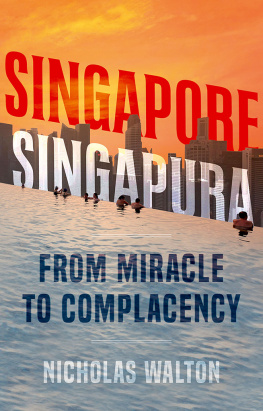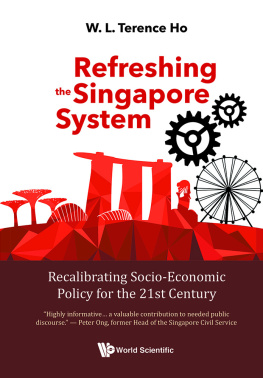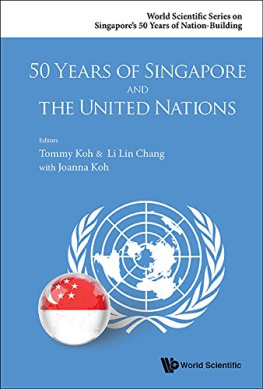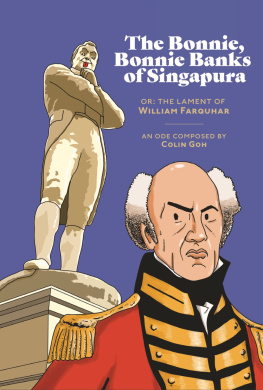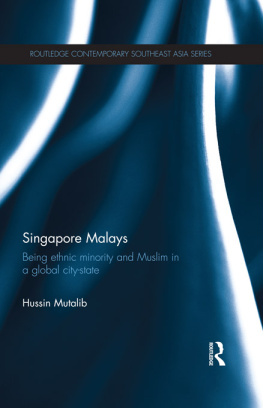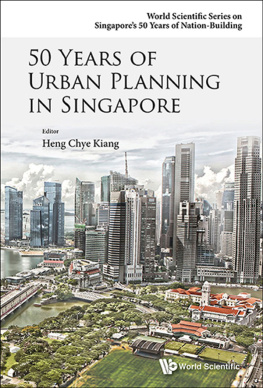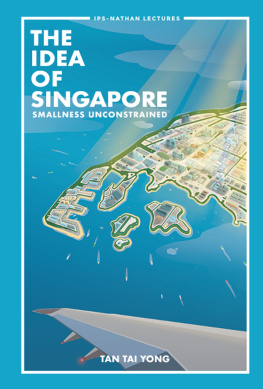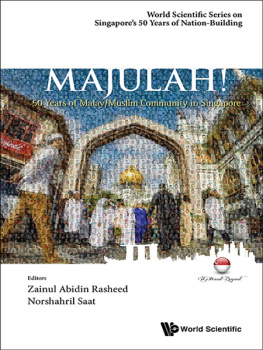SINGAPORE, SINGAPURA
Singapore, Singapura sparkles with life. It is a rare jewel of a bookenchanting, illuminating and at times bloody funny. Much more than a travelogue or history, this is the story of a grand adventure, told in the tradition of Conrad with the eye of Theroux and the wit of Bryson. Brilliant.
James Brabazon, journalist, documentary filmmaker and author of The Break Line
What better way to discover Singapore than to walk across it? In this splendid book, Walton serves up the islands richesits history, geography, economics, and, most of all, serendipity.
Tyler Cowen, author of The Complacent Class and Average Is Over
Walton vividly traces the roots of Singapores miraculous emergence as a global economic hub, warning that its past successes may blind it to the need to evolve in tune with a rapidly changing world. This fascinating book is an evocative guide to the past and future of a remarkable country, with universal relevance to our uncertain era of globalisation and urbanisation.
Alex Beard, author of Natural Born Learners
Join Nicholas Walton on his intriguing voyage of discovery across the length and breadth of Singapore, exploring the islands history from the fourteenth century to the present day.
Mark Leonard, Director of the European Council on Foreign Relations
NICHOLAS WALTON
Singapore, Singapura
From Miracle to Complacency

HURST & COMPANY, LONDON
First published in the United Kingdom in 2018 by
C. Hurst & Co. (Publishers) Ltd.,
41 Great Russell Street, London, WC1B 3PL
Nicholas Walton, 2018
All rights reserved.
Distributed in the United States, Canada and Latin America by Oxford University Press, 198 Madison Avenue, New York, NY 10016, United States of America.
The right of Nicholas Walton to be identified as the author of this publication is asserted by him in accordance with the Copyright, Designs and Patents Act, 1988.
A Cataloguing-in-Publication data record for this book is available from the British Library.
EISBN: 9781787381612
www.hurstpublishers.com
Endpapers: Syonan-to: a Japanese map of Singapore, published in Shashin shh (Photo Weekly) magazine, issue 206, 4 February 1942a few days before the Japanese invasion and occupation of the island.
The Straits: a close-up from a 1944 RAF silk escape map of the region, showing the demarcation between British and Dutch imperial possessions.
To Luca, Jennifer and Stuart.
All three introduced me to equatorial living and taught me to ask questions.
It worked out well.
CONTENTS
I would like to thank the many people who helped me research and write this book. Some gave their time, their insights, or their encouragement; others simply provided unwitting illumination over several glasses of overpriced wine or a post-football can of beer. I apologise if I have missed anybody out. Others do not wish to be named, but I remain grateful.
Thank you to Aleks and Nick Barnes, Megat Castelcage, James Crabtree, Fernando Gandioli, Raymond Goh and AJ, Erica and John Hadfield, Margie Hall, Gordon Hewitt, Lorraine and Jay Sangani, Kenji Kwok, Collin Koh, Koh Seng Choon, Robert Kooij, John Lawson, Kishore Mahbubani, David and Nancy Marazzi, Nick Measures, Steffen Pedersen, Raghavan Raveendran, Kuik Shiao, David Skilling, Alan Soon, Yolanda Taravilla Marin, Pingtjin Thum, Tong Yee, Sudhir Vadaketh, Chris and Carol Van Beek, Keith Wallis, Tony Wagner, William Wan, Charlotte Wilkinson, Taufiq Yussef, Gremelyn Dar Zamora, and all those with whom Ive played Wednesday night football.
Immense thanks are also due to the folk at Hurst, who encouraged me to write this book, and helped it along with advice and expertise. Michael Dwyer was supportive from the off, and lenient when the project took longer than he anticipated. Farhaana Arefin was an excellent editor, and helped turn thousands of words into a viable book. I already knew Jon de Peyer, Daisy Leitch, and Alison Alexanian from my Genoa book, and was delighted to work with them again. Any mistakes are my responsibility entirely, and I apologise in advance to those who spot something Ive missed.
Finally, I need to thank my family. My amazing wife, Ilaria, was responsible for getting us to Singapore in the first place, and was supportive and constructive throughout. Much of my time on the island was spent with our fantastic son, Luca. We explored the place together, negotiating the heat and ramshackle pavements with a pram and then a scooter, seeing things and asking questions. This book is dedicated to him, and to my parents, Jennifer and Stuart, who took me and my brother down from Durham to Nairobi back in 1974, in search of equatorial adventures and a baby sister. Thank you.
On 28 January 1819 a ship called the Indiana, commanded by Captain James Pearl, dropped anchor at St Johns Island, alongside the Enterprise. The men on board were mostly British. Their first job was to ascertain if the Dutch had a presence on the larger island a bare handful of kilometres to the north. The answer was no. The next day a party landed on that larger island, at a point where a river met the warm seas of the narrow straits linking the Indian Ocean with the South China Sea. One of the men was the lieutenant-governor of Bencoolen, on the far side of Sumatra. His name was Stamford Raffles, and he appreciated the potential of the muddy island where he now stood. Raffles landing on that muddy island is recognised as the founding of modern Singapore.
My own arrival in Singapore, almost two centuries later, was more prosaic. I was on the Singapore Airlines red-eye from Milan, descending over a vast flotilla of ships at anchor, dawn still an hour or so away. The prospect of setting up home in the modern worlds model city state pleased me; I was busy tidying up the last pre-publications details of a book on one of its medieval precursors, the Italian city state of Genoa. I had tracked the birth, explosive growth and long decline of Venices great rival, and written about the transsexual prostitutes and basil farmers, Sri Lankan cricketers and chocolate-makers who lived in its labyrinthine streets and vicoli. Singapore was a very different place. It had no medieval streets, and piecing together its history before Raffles landed on its shores two hundred years earlier was tricky. While Genoa smelled to the visiting Charles Dickens like old cheese wrapped in warm blankets, Singapore was the type of place that banned chewing gum.
Nevertheless, I saw parallels between the two. Genoa had come out fighting after finding itself in an unpromising and vulnerable situation. It harnessed hard work, tactical nous, ruthlessness, and the growing trading networks of a rapidly globalising medieval world, and flourished. Against a backdrop of tumbling rocks and arid, salty seas, Genoa had become a vital cog in the birth of the medieval economy, a crucial trading link between East and West, and a keystone in a new world order. Likewise, modern Singapore had been thrust into an unwelcoming world after being spat out by the Malay Federation in 1965. It too harnessed hard work, tactical nous, ruthlessness, and the growing trading networks of a rapidly globalising world, and it too had flourished.
The case of Genoa also carried a warning. It had remained small, agile and vital, working hard and shifting business models to stay relevant in a rapidly evolving world. But eventually, after a couple of centuries of glory, it started to lose ground and was inevitably enveloped by the fog of slow, centuries-long decline. Singapore, too, is small, agile and vital, and its admirable government has worked hard to shift business models and find relevance in a rapidly evolving world. The extraordinary successes of its first half-century of independence belied the poor inheritance of a tiny, muddy island in a hostile equatorial neighbourhood. But as it neared the fiftieth anniversary of independence (and the 200th anniversary of its founding by Raffles), valid questions were being raised about how it was going to plot its course in the future. Was the Singapore miracle a mere fifty-year affair, or would it be something more enduring?

